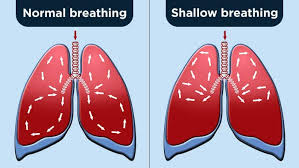The Latin word Inspiritus means “to breathe,” but it also contains “spirit.” To inspire is literally to breathe in Spirit, to be filled with life, vitality, and even the divine. It is also the root of “inspiration,” meaning to be touched by the muses, by creativity, by something larger than ourselves. But when we’ve experienced chronic stress, trauma, or developmental overwhelm, our inspiration often disappears into the background. The natural rhythm of breath, that effortless rise and fall, can become dysregulated alongside the nervous system. Instead of flowing, breath becomes controlled: shallow, held, forced, or restricted.
This is not weakness; it’s survival. Breath is deeply tied to the autonomic nervous system. Under threat, our body activates ancient survival pathways. The vagus nerve, fight-or-flight responses, and patterns of freeze or collapse shape how we breathe.
For instance:
-
Shallow, rapid breathing signals sympathetic arousal (fight/flight).
-
Held or absent breath often reflects freeze or shutdown.
-
Overly controlled deep breaths can be a way of suppressing rather than integrating trauma.
Why “Just Taking Deep Breaths” Isn’t Enough
Many of us are taught to override discomfort with deep breaths: to force calm. But neuroscience and somatic psychology suggest this misses the deeper invitation. When we breathe over an old traumatic memory, the body doesn’t complete its survival response. Instead, the unfinished patterns remain stored, resurfacing as anxiety, chronic pain, or inflammation.
What if, instead, we let the breath guide us?
This doesn’t mean collapsing into chaos, but noticing:
-
How the breath wants to move.
-
Where sensations arise in the body.
-
Whether impulses ~ a shake, a stretch, a push ~ want completion.
Allowing breath to move naturally often creates a spontaneous release, an exhale that feels different, an emotional wave, or an involuntary shift in posture. These are signs of integration, the nervous system resetting itself, finding coherence.
The Science of Breath and Nervous System Coherence
Research in psychophysiology shows that breathing modulates key systems of the body:
-
Heart rate variability (HRV): a marker of resilience and adaptability.
-
Vascular rhythm and blood pressure: linked to parasympathetic balance.
-
Muscle tone: shaped by vagal regulation and trauma states.
When trauma remains unresolved, these systems lose coherence. Breath becomes fragmented, rhythms fall out of sync, and the body’s innate self-regulation is disrupted. But as we allow the breath to find its natural flow, coherence returns. Body and mind self-organize. Spirit, inspiration, reenters.
An Invitation
Take a moment now:
-
Sense the rhythm of your breath.
-
Notice how it moves through your chest, belly, back, even your skin.
-
Ask: Does my breath inspire me to take in life? Or does it protect me from it?
Breath reveals both vulnerability and power. By attuning to it, we reconnect not only to physiology but also to Spirit, the felt sense of being part of something greater.
Breathing in this way is not just about oxygen. It is about reawakening inspiration: to create, to connect, and to live fully alive.
If you feel your breath is shaped by old trauma or overwhelm, you don’t have to navigate this alone. Somatic therapies like Somatic Experiencing help restore nervous system coherence so you can breathe, and live, more freely.
✨ Ready to reconnect with your inspiration? Book a session with Jaya
If you would like to learn more about the Fight/Flight/Freeze and Fawn response and how to integrate it to free up your breath more, click here!





